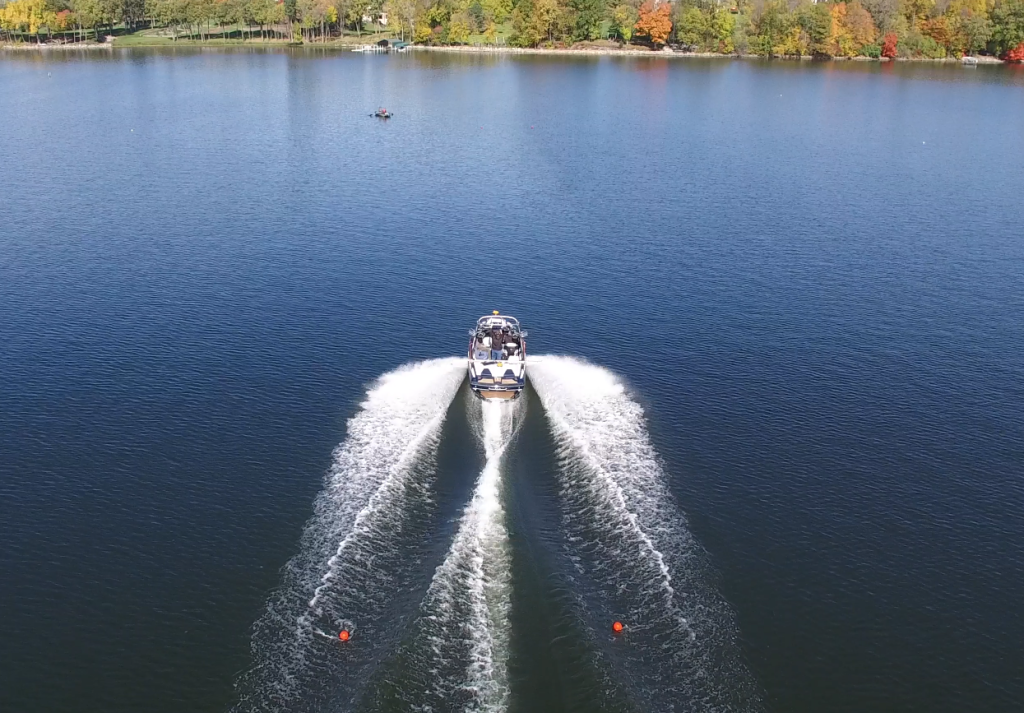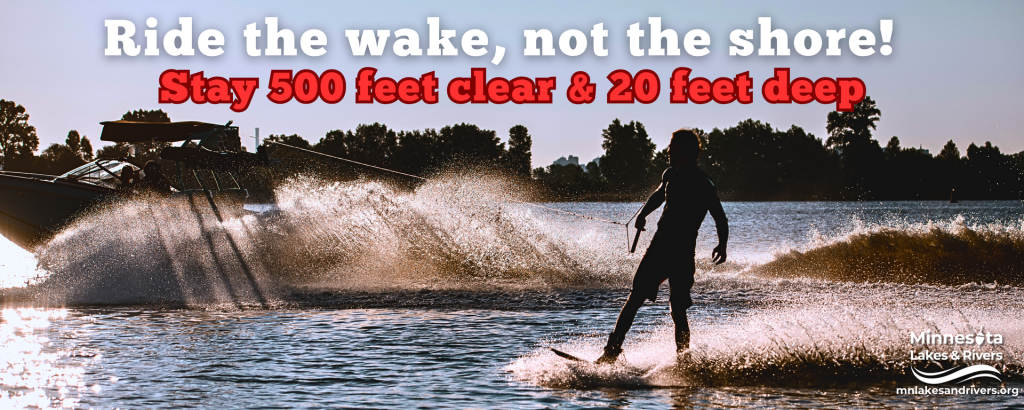By Sami Selter, Associate Executive Director
What Minnesota’s Lakeshore Communities Need to Know About Enhanced Wakes.

In 2020, as the pandemic drew more people to Minnesota’s lakes, communities raised urgent concerns about the rise of wake-surfing boats and their impact on our waters. With most existing research either limited or industry-funded, Minnesota Lakes and Rivers Advocates recognized the need for trusted, science-based information. In response, we launched a grassroots crowdfunding campaign to kickstart the Healthy Waters Initiative—an effort that funded the first phase of independent, expert-reviewed research at the University of Minnesota’s St. Anthony Falls Laboratory.
Phase 2 Research Webinar
The research team will present a virtual webinar on Tuesday, August 26th, 2025, at 6pm CT via the St. Anthony Falls Laboratory Seminar Series. If you are interested in joining, please register and submit questions here: Webinar Registration.
Key Findings from Phase 1/2
- Wave Height and Energy: At 100–200 feet—the distance recommended by the Minnesota DNR for all boats—wakeboats generate waves that are 1.4 to 2.3 times higher than those produced by typical ski boats or cruisers. These larger waves deliver significantly more energy to shorelines.
- Wave Persistence: Wakeboat waves maintain much of their size and energy over long distances, traveling 500 to 1,000 feet beyond the point of generation. This extended reach increases their impact well beyond the immediate wakesurfing area.
- Shoreline Impact: The wave heights and energies often exceed thresholds known to cause shoreline erosion. This increases the risk of property damage, habitat loss, and sediment disruption, especially in shallow lake environments.
- Underwater Currents: Wakeboats generate strong propeller-driven currents near the lake bottom, with speeds exceeding 1 foot per second. These currents are capable of resuspending sediments from the lakebed.
- Sediment Suspension: Once disturbed, sediments can remain suspended in the water column long after the wakeboat has passed. This reduces water clarity, stresses aquatic plants and animals, and may introduce excess nutrients that fuel algae blooms.
What Can We Do With This Information?
The research provides clear best practices when using enhanced wake modes, boats should stay at least 500 feet from shore -about the length of a city block- or other boats and operate only in water 20 feet deep or more.
Minnesota Lakes and Rivers was successful in passing mandatory boater safety in the state. We developed the curriculum with the DNR and the boat manufacturing industry to include the new guidelines, ensuring every boater learns how to minimize shoreline impacts.
We are also creating Wake-Safe Maps for member lake associations. These maps use lake bathymetry data to visually show where enhanced wake boating is recommended—not as regulation, but as education. This peaceful, science-backed approach helps reduce conflicts and build community consensus. Boaters can now see where they can wakesurf with minimal impact to the shore.
The Enforcement Challenge
A 2024 bill proposing a statewide ban on wake surfing outside designated zones failed amid heavy industry lobbying and legislative opposition. Regulating wake-enhanced boating remains a challenge not only in Minnesota but in other states. In 2024, New Hampshire’s senate killed a bill limiting wake surfing by distance to shore. Maine’s 2023 proposed statewide ban on wake surfing on inland waters failed after pushback from wake boat owners and rental businesses. Idaho, Michigan, Maine, Wisconsin, and Oregon have also seen proposed statewide regulations defeated, leading instead to region- or waterbody-specific restrictions.
Vermont is the only state to pass statewide wake boat regulation, prohibiting wake boats on lakes smaller than 50 acres and within 500 feet of shore at depths less than 20 feet. However, only 30 inland lakes currently meet these criteria for wake surfing, and some local lake associations are petitioning to prohibit wake sports altogether. Advocates argue the distance-from-shore regulation does not fully protect lakes from the spread of aquatic invasive species.
Where statewide regulation isn’t successful, communities turn to local ordinances. Minnesota communities considering this approach should look to Wisconsin’s patchwork of local rules dating back to 2008. These laws illustrate that without strong local enforcement, ordinances risk becoming symbolic rather than actionable.
This is because citizens cannot act as law enforcement. Wisconsin DNR boating law administrator Darren Kuhn cautions against “citizen enforcement,” noting concerns about asking residents to make legal and prosecutorial decisions. While citizen reports, including photos or videos, can alert authorities, legal action requires direct officer observation and interaction with the boater. Without this, local ordinances may face legal challenges and possible repeal.
Enforcement requires formal channels, typically through local officers or DNR wardens who have authority to stop vessels with reasonable suspicion. Even then, officers must have probable cause or consent to board boats. This responsibility often makes officers hesitant to issue citations, especially if boaters claim ignorance or relocate to less-enforced areas. Furthermore, citation fines—often around $150—may not deter wakeboat owners willing to invest heavily in their vessels.
As a result, real-world enforcement is rare. Many Wisconsin towns have passed enhanced-wake laws but issued few or no citations. One attorney remarked, “The number of times in the entire state of Wisconsin that any of these ordinances has been enforced is zero.”
Minnesota Lakes and Rivers Advocates is working to create safer, healthier lakes by promoting education and science-based best practices. Just as Minnesota successfully integrated snowmobiling through training and trail systems, we can address wake-related concerns through local education, strong visuals, and shared understanding—balancing recreation with shoreline and habitat protection.

